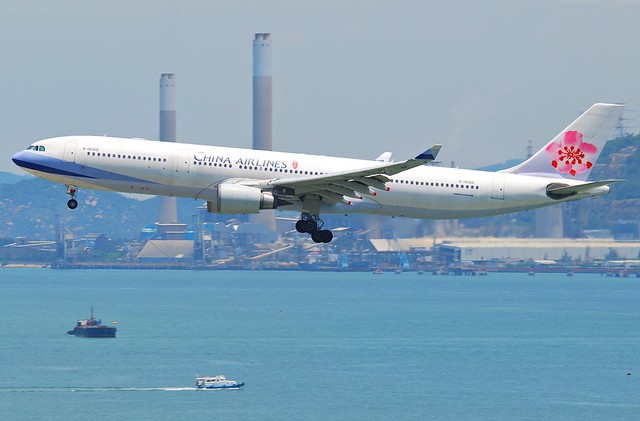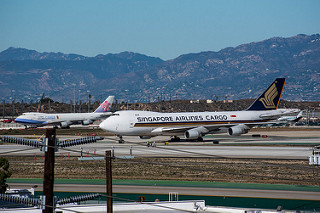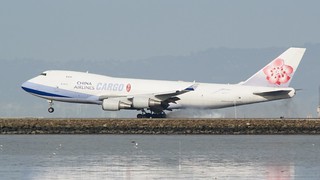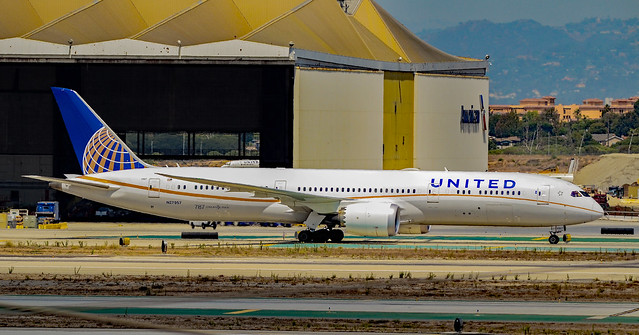China Airlines B744 at Atlanta on May 19th 2013, flap separated from wing
Last Update: August 8, 2014 / 13:18:23 GMT/Zulu time
Incident Facts
Date of incident
May 19, 2013
Classification
Accident
Airline
China Airlines
Departure
Anchorage, United States
Destination
Atlanta, United States
Aircraft Registration
B-18701
Aircraft Type
Boeing 747-400
ICAO Type Designator
B744
The onward flight to Dallas Ft. Worth,TX (USA) was cancelled.
The FAA reported the Boeing 747-800 landed without further incident after a trailing edge flap had separated from the wing on May 20th.
China Airlines do not (yet) operate Boeing 747-800s. Flight CI-5254 did not operate on May 20th. Upon query by The Aviation Herald with these details the FAA confirmed the incident occurred on May 19th, further details (including aircraft type, tailnumber, location of flap separation, info on whether the flap has been located) are under investigation.
A resident living on the extended center line about 4.25nm east of the threshold of Atlanta's runway 27R reported a 20 feet/6 meters long piece of an aircraft fell onto the roof of her home on Sunday (May 19th) afternoon causing two holes in the roof before the piece fell into the yard.
Police reported the 20 feet long piece belonged to the right wing of the China Airlines Boeing 747. The flaps section, that separated from the wing, broke in two parts, impacted the fuselage causing substantial damage to the fuselage, too, and fell to the ground.
On Nov 7th 2013 the NTSB released a preliminary report into a ground incident at Dallas Ft. Worth involving B-18701 which may have a bearing into this occurrence stating, that while taxiing after landing on Feb 25th 2013 the aircraft encountered a #2 (inboard left hand) engine fire as result of a #2 fuel feeder line leak, the fire was extinguished with the discharge of the onboard fire suppression system. The engine was replaced, no aircraft damage had been reported, the NTSB stated.
On Feb 12th 2014 the NTSB released their preliminary report into the accident in Atlanta stating, that the inboard fore flap departed the right hand wing while on approach to Atlanta's runway 27L. The crew reported parts falling off the right hand wing, declared emergency, went around and landed safely on Atlanta's runway 28. A 20 feet and a 3 feet section of the right inboard fore flap were located about 4-5nm east of the aerodrome.
On Aug 7th 2014 the NTSB released their final report concluding the probable cause of the occurrence was:
Failure of the right inboard foreflap outboard fitting due to fatigue and bearing anomalies on the sequence carriages which resulted in the partial separation of the right inboard foreflap. Contributing to the incident was the failure of maintenance personnel to detect the fatigue cracking and bearing anomalies during dedicated inspections.
The NTSB reported that the #4 carriage toggle assembly showed damage in two areas, the detent roller exhibited a flat spot, significant play between inner and outer races, and was seized preventing rotation, two of the flight load rollers and one deadweight roller showed flat spots.
The #5 carriage toggle assembly showed fractured clevis arms, which had separated from the assembly along with the roller, the fracture faces showed traces consistent with ductile overstress separation. The outer races of the flight load rollers were fractured and partly separated, the attachment lugs deformed, one of the dead weight rollers was fractured and the outer race missing.
The #6 carriage toggle assembly contained a dead weight roller with an incorrect part number.
The #6 sequence carriage attachment fitting was fractured through the lug consistent with fatigue spanning, portions consistent with ductile stress separation. The fracture began at the lug bore, there was considerable corrosion pitting throughout the lug bore.
The #4 carriage toggle assembly had been replaced with an overhauled unit in 2005 for unknown reasons, in 2012 the #5 carriage toggle assembly had been replaced with an overhauled unit after the detent rollers had become worn. There were no records the #3 and #6 carriagle assemblies had been replaced since manufacture of the aircraft.
Incident Facts
Date of incident
May 19, 2013
Classification
Accident
Airline
China Airlines
Departure
Anchorage, United States
Destination
Atlanta, United States
Aircraft Registration
B-18701
Aircraft Type
Boeing 747-400
ICAO Type Designator
B744
This article is published under license from Avherald.com. © of text by Avherald.com.
Article source
You can read 1 more free article without a subscription.
Subscribe now and continue reading without any limits!
Read unlimited articles and receive our daily update briefing. Gain better insights into what is happening in commercial aviation safety.
Send tip
Support AeroInside by sending a small tip amount.
Related articles
China Airlines A333 near Taipei on Jan 20th 2024, cabin pressure anomaly
A China Airlines Airbus A330-300, registration B-18309 performing flight CI-919 from Taipei (Taiwan) to Hong Kong (China), was enroute at FL360 about…
China Airlines B738 near Osaka on Dec 11th 2023, cracked windshield
A China Airlines Boeing 737-800, registration B-18661 performing flight CI-7760 from Kaohsiung (Taiwan) to Takamatsu (Japan) with 153 people on…
China Airlines B744 at Chicago on Jun 21st 2018, veered off the runway and went around
A China Airlines Boeing 747-400 freighter, registration B-18711 performing freight flight CI-5148 from Anchorage,AK to Chicago O'Hare,IL (USA) with 4…
China Airlines B744 at Chicago-O'Hare on Jan 29th 2022, collision with containers on ground
A China Airlines Cargo Boeing 747-400F freighter, registration B-18715 collided with several objects (cargo containers, pallets) on the ground while…
China Airlines B744 at Taipei on Jan 16th 2022, engine trouble
A China Airlines Boeing 747-400, registration B-18715 performing flight CI-5240 from Taipei (Taiwan) to Anchorage,AK (USA), was climbing out of…
Newest articles
United B789 near Singapore on May 14th 2024, uncontained engine failure
A United Boeing 787-9, registration N27957 performing flight UA-28 from Singapore (Singapore) to San Francisco,CA (USA) with 197 passengers and 14…
Safair B738 at Johannesburg on Apr 21st 2024, dropped wheel on departure
A Safair Boeing 737-800, registration ZS-FGE performing flight FA-212 from Johannesburg to Cape Town (South Africa) with 178 passengers and 6 crew,…
Subscribe today
Are you researching aviation incidents? Get access to AeroInside Insights, unlimited read access and receive the daily newsletter.
Pick your plan and subscribePartner

A new way to document and demonstrate airworthiness compliance and aircraft value. Find out more.

ELITE Simulation Solutions is a leading global provider of Flight Simulation Training Devices, IFR training software as well as flight controls and related services. Find out more.

Your regulation partner, specialists in aviation safety and compliance; providing training, auditing, and consultancy services. Find out more.
AeroInside Blog
Popular aircraft
Airbus A320Boeing 737-800
Boeing 737-800 MAX
Popular airlines
American AirlinesUnited
Delta
Air Canada
Lufthansa
British Airways








